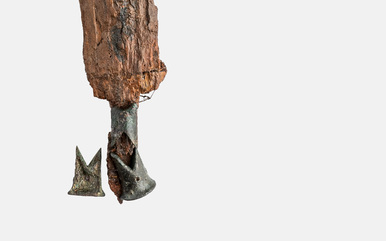In 2015–2016, a group of the “Arkaim” Museum-Reserve and Chelyabinsk State University explored five burial mounds of the Mandesarka-6 burial ground in the Kizilsky District of the Chelyabinsk Region. The necropolis is located in the steppe zone at the top of the Mandesarka and Kayrakhta rivers divide. Burial mounds are located in one chain from west to east for 250 meters. The archeologists registered eleven fills, nine of which are circular in shape, one is oval, and one is “dumbbell-shaped”. “Dumbbell-shaped” structures, as well as circular and rectangular earthwork fences and their versions, are a very distinctive feature of the burial and memorial space of the necropolises of the South Urals nomads that roamed in the second half of the 2nd — 3rd centuries AD. The arrangement of the necropolis structures in a linearly oriented composition, “fitted” into the latitudinal landscape structure, is also traditional for the South Urals burial grounds of this period.
The height of the fill of the second burial mound is 0.2 meters and its diameter is 14 meters. A rectangular grave pit was found in the center of the mound. At the bottom of the pit, a poorly preserved framed wooden structure is fixed along the perimeter. Short end planks lay on top of the long longitudinal planks. The latter slightly extend beyond the rectangular outlines, forming a kind of “handles” of a stretcher. One skeleton was found at the bottom of the grave chamber. It is stretched out on its back, with the head to the north, the arms along the torso, the legs stretched out, and the skull crushed by the soil. The grave goods were found within a wooden frame. Behind the skull, some fragments of a ceramic vessel were found.
On the left of the buried person there was an iron
sword without a pommel and cross-guard. Nomads actively armed and militarized
their society in order to protect pastures and water sources, to control trade
routes and raw material centers. This is confirmed by the following: in the
Mandesarka-6 burial site men were buried with melee weapons — daggers and
swords. The burials of other nomads abounded with weapons, sometimes women’s
burials as well. Military clashes took place both between nomadic tribes and
during raids and wars with the settled population. Ancient civilizations often
took advantage of this: the armies of ancient Persia and the Roman Empire had
military contingents from Saka and Sarmatian tribes.

